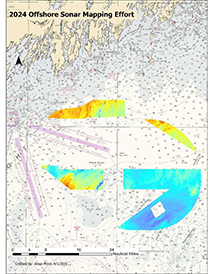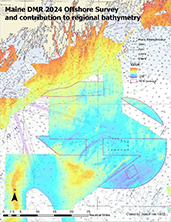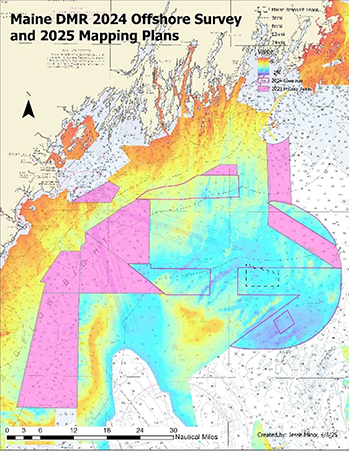
In 2024, with funding from the Governor’s Energy Office and the Research Consortium for Offshore Wind, MCMI hired and outfit an offshore-capable vessel (the F/V Titan) for multi-day survey operations in the Gulf of Maine. To staff the research vessel, MCMI hired and trained seven contractors on the technical elements of sonar operations and on visual survey methodologies for wildlife observations. Additionally, Biodiversity Research Institute (BRI) installed a passive acoustic bat sensor on the offshore survey vessel to listen for bats during nighttime survey efforts. The purpose of the 2024 mapping survey was to collect high-resolution bathymetry and acoustic backscatter in the Maine Research Array floating offshore lease area and along potential power export cable routes to shore, and to fill data gaps between and adjacent to prior bathymetric surveys. The offshore survey supports ongoing and future oceanographic surveys, habitat assessments, resource management, and marine development planning.
The F/V Titan completed eight multi-day trips between August 1st and October 23rd, each trip ranging in length between 3 and 7 days. During mapping surveys, the DMR crew conducted 24-hour sonar operations and collected daylight-hour wildlife observations. The mapping was tremendously efficient, adding a total of 337 nmi2 new bathymetric coverage in 34 days of mapping. This required driving 2,001 linear survey miles and collecting 89 miles of crosslines to support quality control and final data processing. MCMI’s mapping efforts made great contributions to regional bathymetric and backscatter coverage.

miles in 34 days.
After processing, QA/QC, and statistical validation, MCMI’s mapping data and hydrographic descriptive report are provided to the National Oceanic and Atmospheric Administration (NOAA) to make important updates to navigational charts, and the data are available at NOAA’s National Centers for Environmental Information (NCEI) Bathymetric Data Viewer. Initial bathymetric and backscatter surfaces are uploaded to the Northeast Ocean Data Portal, and we replace the initial surfaces with statistically validated final surfaces as soon as possible. MCMI frequently updates the webmap of our bathymetric survey data on the DMR website.

bathymetric coverage in the Gulf of Maine
The wildlife observations collected on the F/V Titan were important for understanding the use of these offshore areas by marine mammals and seabirds. MCMI’s observers recorded a total of 314 marine mammals, including 18 unidentified whales, 87 unidentified dolphins, 84 Common Dolphins, 29 Long Finned Pilot Whale, 1 Humpback Whale, 1 Harbor Seal, 11 Bottlenose Dolphins, and 83 Atlantic White Sided dolphins. MCMI’s wildlife observers also counted 2,771 seabirds representing 26 species. Finally, BRI’s bat detector recorded 89 bats during the survey season.

observing wildlife aboard the F/V Titan

observing wildlife aboard the F/V Titan
This project is continuing in 2025, and we will fill a large number of data gaps remaining between MCMI and NOAA’s previous surveys. In 2025, we plan to map an additional 503 nmi2 and create large areas of seamless bathymetry and backscatter that provide essential inputs into habitat maps and support a variety of marine planning and scientific efforts.

nautical miles of additional survey coverage
in 50 days at sea on the F/V Titan.

collects sonar data at night on the F/V Titan